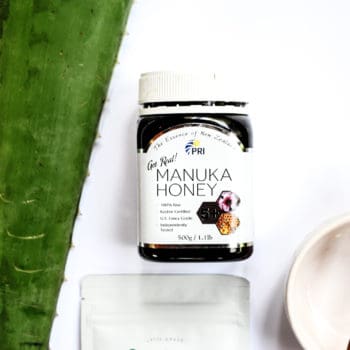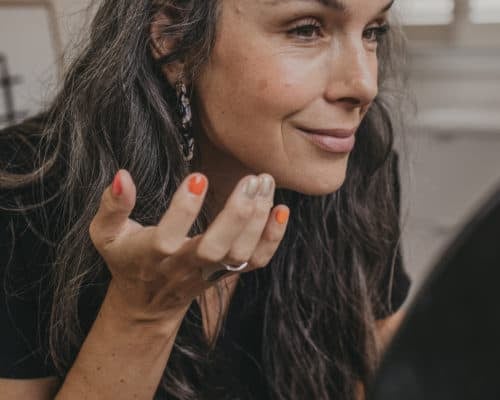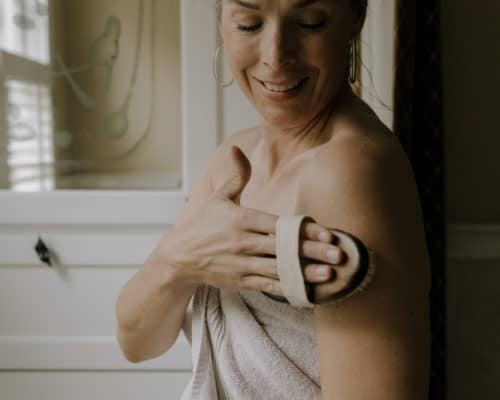A nourishing antioxidant mask that works to even skin tone, hydrate, improve elasticity, plump, brighten and reveal glowing skin. Great for all skin types!
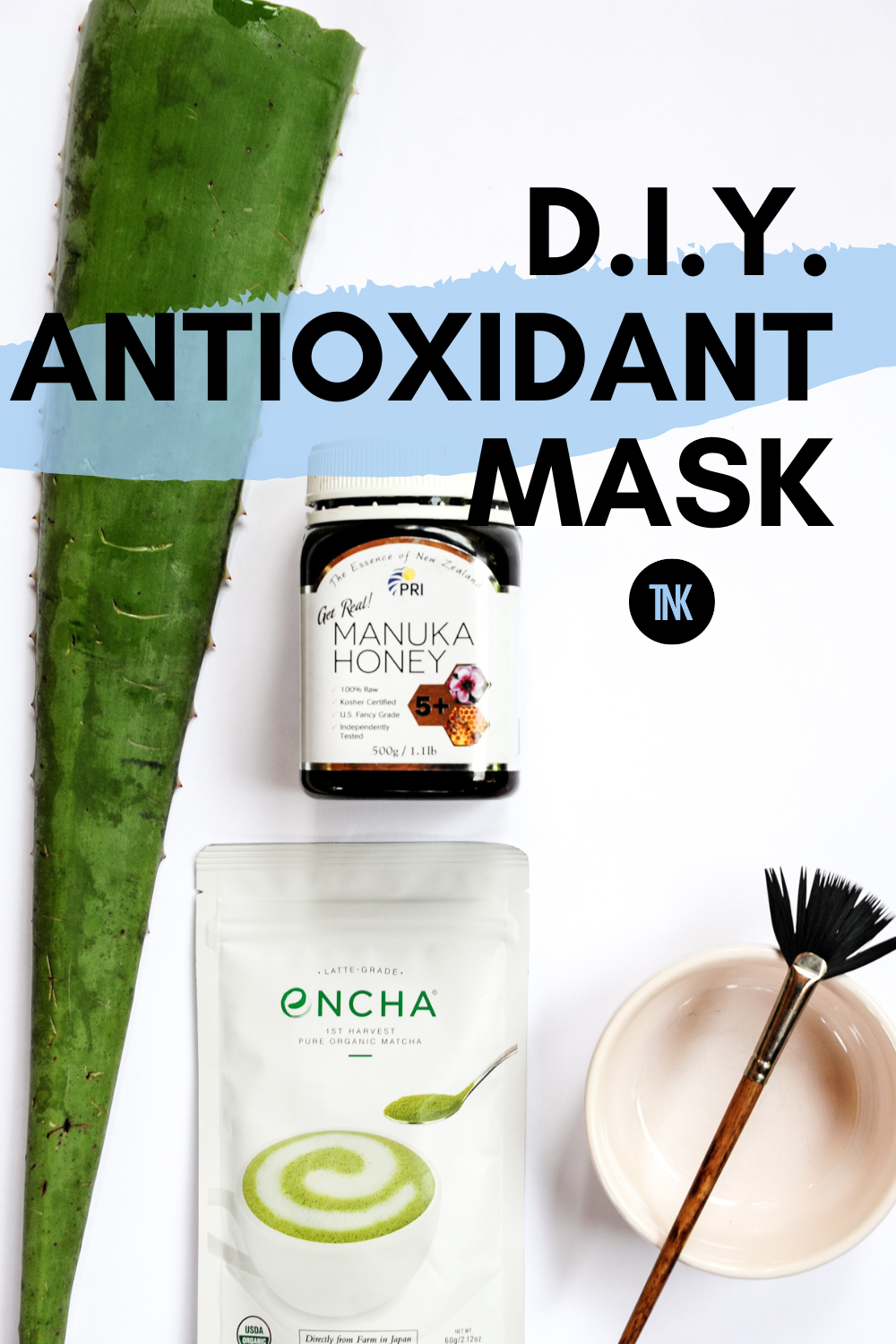
Thank you to Pacific Resources International for partially sponsoring this post.
So excited to bring you our new DIY skincare series! This is our first post in the series but in the future be sure to search “DIY” on the blog and all of our original skincare recipes will populate.
RELATED: DIY Moisturizing Face Mask pair it with our DIY exfoliating scrub and the DIY facial oil from Laurel Skin founder.
Okay first lets clear the air. I’m not a “DIY-er” by nature. I am a woman of convenience. We all know this. I love convenience when it comes to, well everything. I’m talking food, skincare, nails house cleaning…the works. My default is to buy it before making it BUT that’s not to say I don’t appreciate homemade. Homemade is the best. And when it comes to skincare you can’t beat fresh aloe from the plant or choosing your own honey or matcha and not having to add a preservative. I mean talk about FRESH.
I also thought this DIY series would be a nice addition considering so many of us are home right now. I wanted to help create some fun skincare treats we can indulge in, in the comfort of our own kitchen.
I also wanted to make this series LEGIT so I enlisted the help of our go-to esthetician Jamie Leigh and owner of Modern Holistic here in Atlanta to give us some esthetician created and approved recipes. And as always, Kate Noonan, cosmetic chemist and molecular biologist, guides us here as well.
This first recipe is an antioxidant powerhouse delivering deep hydration and nourishment and its fantastic for all skin types. Even better? It’s made with only three ingredients; matcha, aloe vera gel and Manuka.
RELATED: Read more of my natural skincare products recommendations.
Manuka Honey
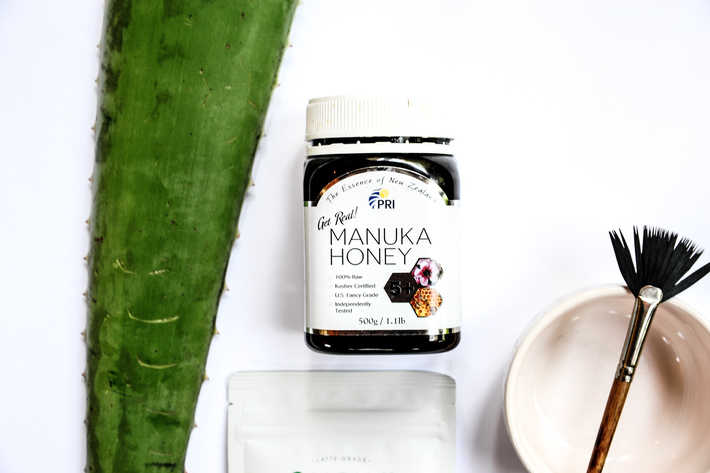
Consider Manuka natures Neosporin. It’s different than any other honey and it can legit treat every skin problem known to man including acne, eczema, dry skin and more.
Jamie explains, “This beautiful nectar is known to be a humectant, which plumps the skin with hydration. It’s also anti-bacterial, antiviral and antimicrobial.”
What sets Manuka apart? Manuka contains what’s called Methylglyoxal (MG)—an antibacterial action not deactivated by the human body’s natural defenses. The higher the MG rating, the more active the honey. I like PRI Manuka because they have every batch of honey’s MG tested by an independent lab so as a consumer, I know what I’m getting is LEGIT.
Here’s what else Manuka can do for the skin…
- Gently nourishes skin and doesn’t strip skin of its natural oils.
- Has a low pH level (4.4) (1) which bacteria does not thrive in.
- Acts as a light exfoliator – especially when you practice honey tapping.
- Has anti-inflammatory properties (2) and can decrease inflammation caused by acne and blemishes.
- Has antibacterial properties (1) and can help eliminate bacteria on your face that may be contributing to flare-ups.
- Has been shown to accelerate wound care (1) and can help heal existing blemishes.
- Delivers vitamins (2) (B2, B4, B5, B6, B11 and C), minerals (calcium, iron, zinc, potassium, magnesium, selenium..), antioxidants (flavonoids), enzymes, amino acids…
- Is antiseptic and cleanses the skin (2).
- Promotes rehydration by drawing moisture to the skin (2).
- Improves softness and texture (2).
Matcha
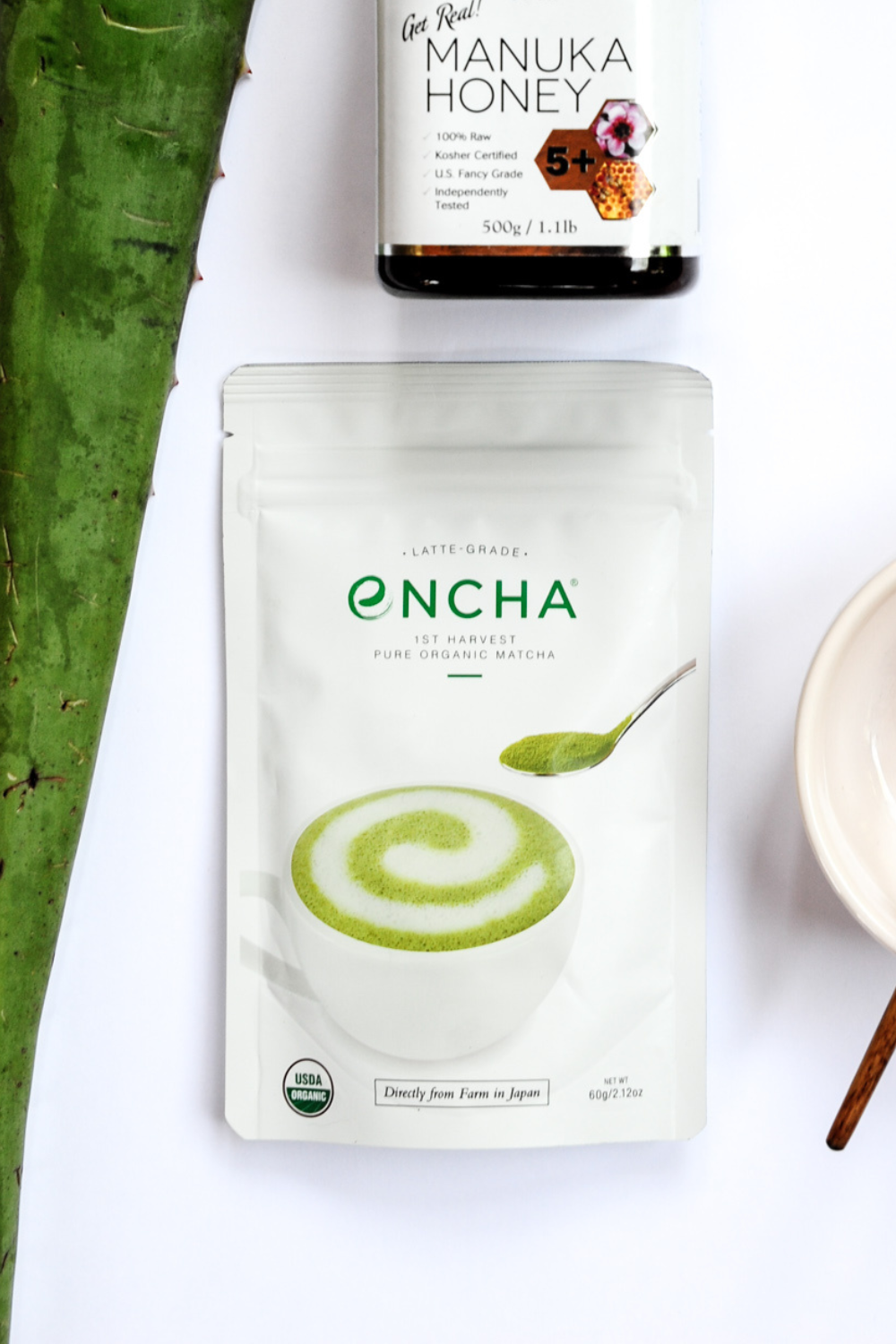
Matcha is a super potent antioxidant. And even more potent when its grown in the shade and is harvested as a baby tea leaf at peaking point of antioxidant levels. Jamie recommends Encha which is the same matcha we are seeing in the new Erin’s Faces Matcha Mascara. A top choice but ultimately, any matcha you have on hand will be a fortifying addition.
Green tea matcha also helps to plump and hydrate skin. It’s rich in antioxidants that are well known for directly improving skin’s elasticity by lowering oxidative stress compounds that would otherwise bind to collagen fibers and cause skin aging and fragility (3). Green tea also boosts healthy collagen production and improves skin hydration (4).
Aloe Vera Gel
Aloe vera gel is the queen of anti-inflammatory properties. It’s very soothing, hydrating and works balance skin’s pH.
You can use any aloe vera gel you have on hand. If you are looking to buy a bottle, I like the Bader Aloe Vera Gel. However, nothing beats the potency of fresh aloe. Check out just some of the benefits of aloe on skin:
- Aloe vera helps lock water in skin by replenishing essential stratum corneum free amino acids. It boosts healthy collagen production and its enzymes and antioxidants neutralize damaging free-radicals (5).
- Aloe also balances skin’s pH and hydration level for optimal barrier function, ceramide production, and cell turnover (6).
- Skin absorbs Vitamin C and other antioxidants better in the presence of aloe vera gel, which has Vitamin C content on its own as well (5).
- Aloe has been very useful for improving intact and wounded skin, with notable studies on patients’ skin by U Penn Medical School, U of Texas Health Science Center, Kindai University in Japan, and other universities (5).
If you have your own plant, break off one of the leaves and scoop out the flesh. Some of the flesh can be chunky, try to aim for the more slimy bits that have a more homogenous consistency. You may have to scoop around a bit to get there. It will make for a smoother application and better user experience.
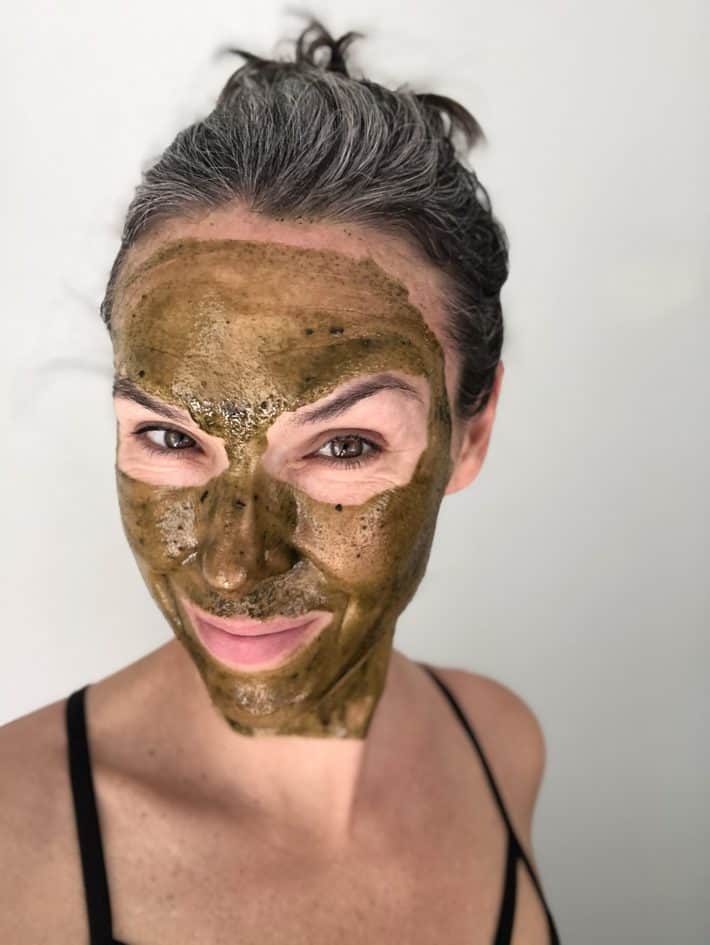
Reader reviews of DIY honey mask
“Loved the mask!” —Allyson
“It was lovely! I left it on for 20-25 minutes and it definitely had some smoothing properties. When I went to wash my face again at the end of the day, the texture was noticeably smoother!” —Golden

DIY Aloe Vera & Honey Face Mask
Equipment
- Mask brush (or fingers)
- Mask bowl (or small bowl)
- Small whisk or mixing device
Ingredients
- 1/2 tsp matcha powder sifted
- 1/2 tsp aloe vera gel juice or scrapped from the plant
- 1 tsp PRI manuka honey raw & unrefined
Instructions
- Apply 1 teaspoon of PRI Manuka to a small bowl.
- Add 1/2 teaspoon of Matcha.
- Add 1/2 teaspoon of aloe vera gel (fresh or bought).
- Incorporate well with a mask brush or a small whisk.
- Using a mask brush or finger tips, gently apply the mask to the face and neck.
- Leave on for 10 minutes.
- Remove the mask with a warm/hot washcloth (or herbal tea compressing method coming soon to the blog).
- GLOW ON!
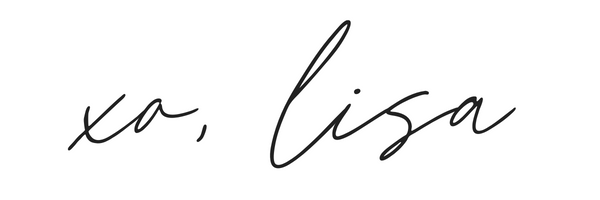
TNK Team Note: This article contains affiliate links. TNK uses affiliate links as a source for revenue to fund operations of the business and to be less dependent on branded content. TNK stands behind all product recommendations. Still have questions about these links or our process? Feel free to email us.
REFERENCES:
1. Simon, Arne; Traynor, Kirsten; Santos, Kai; Blaser, Gisela; Bode, Udo; Molan, Peter; Medical Honey for Wound Care—Still the ‘Latest Resort’?; Hindawi, Evidence Based and Complementary Alternative Medicine, Jan 7th, 2008; https://www.ncbi.nlm.nih.gov/pmc/articles/PMC2686636/
2. E. R. H. S. S. Ediriweera; N. Y. S. Premarathna; Medicinal and cosmetic uses of Bee’s Honey – A review; An International Quarterly Journal of Research in Ayudera, Apr. – Jun. 2012; https://www.ncbi.nlm.nih.gov/pmc/articles/PMC3611628/
3. Chiu AE, Chan JL, Kern DG, Kohler S, Rehmus WE, Kimball AB. Double‐blinded, placebo‐controlled trial of green tea extracts in the clinical and histologic appearance of photoaging skin. Dermatologic surgery. 2005 Jul;31:855-60.
4. Xiao X, Liu Y, Ji L, Xie L, Wu S, Liu Z. Camellia cake extracts reduce burn injury through suppressing inflammatory responses and enhancing collagen synthesis. Food & Nutrition Research. 2020 Mar 6.
5. Hekmatpou D, Mehrabi F, Rahzani K, Aminiyan A. The Effect of Aloe Vera Clinical Trials on Prevention and Healing of Skin Wound: A Systematic Review. Iranian journal of medical sciences. 2019 Jan;44(1):1.
Laux A, Gouws C, Hamman JH. Aloe vera gel and whole leaf extract: functional and versatile excipients for drug delivery?.
6. Azizi WM, WS A, AK A, NA SN. Clinical Efficacy of Aloe Vera Based Products Available in the Market as Skin Moisturiser Measured by TEWL Value and Skin Hydration Level by Using DermaLab Technology. Pharmacologyonline. 2016 Aug 30;2(1):42-9.
7. Kwak BM, Han L, Lee DS, Ju YW, BYUN SY. Enhanced expression of dermal aquaporins by polysaccharide from Camellia sinensis. Bioscience. 2018;2:8.
8. Sharangi AB. Medicinal and therapeutic potentialities of tea (Camellia sinensis L.)–A review. Food Research International. 2009 Jun 1;42(5-6):529-35.
9. Brahmachari G. Aloe vera: a promising hope against Buruli ulcer. InDiscovery and Development of Therapeutics from Natural Products Against Neglected Tropical Diseases 2019 Jan 1 (pp. 373-383). Elsevier.
10. Esteban A, Zapata JM, Casano L, Martín M, Sabater B. Peroxidase activity in Aloe barbadensis commercial gel: probable role in skin protection. Planta medica. 2000 Dec;66(08):724-7.
11. Fulton Jr JE. The stimulation of postdermabrasion wound healing with stabilized aloe vera gel‐polyethylene oxide dressing. The Journal of dermatologic surgery and oncology. 1990 May;16(5):460-7.
12. Heck E, Head M, Nowak D, Helm P, Baxter C. Aloe vera (gel) cream as a topical treatment for outpatient burns. Burns. 1981 Mar 1;7(4):291-4.
13. Lefsih K, Iboukhoulef L, Petit E, Benouatas H, Pierre G. Anti-inflammatory and Antioxidant Effect of a ᴅ-galactose-rich Polysaccharide Extracted from Aloe vera Leaves. Adv Appl Chem Biochem. 2018;1:18-26.
14. Moriyama M, Moriyama H, Uda J, Kubo H, Nakajima Y, Goto A, Akaki J, Yoshida I, Matsuoka N, Hayakawa T. Beneficial effects of the genus Aloe on wound healing, cell proliferation, and differentiation of epidermal keratinocytes. PloS one. 2016;11(10).
15. Shelton RM. Aloe vera: its chemical and therapeutic properties. International journal of dermatology. 1991 Oct;30(10):679-83.
16. Tan WN, Laili CR, Hamdan S. Aloe Vera Liquid Crystal Emulsion and Characterization of its Physical Properties. InSolid State Phenomena 2018 (Vol. 273, pp. 122-127). Trans Tech Publications.

